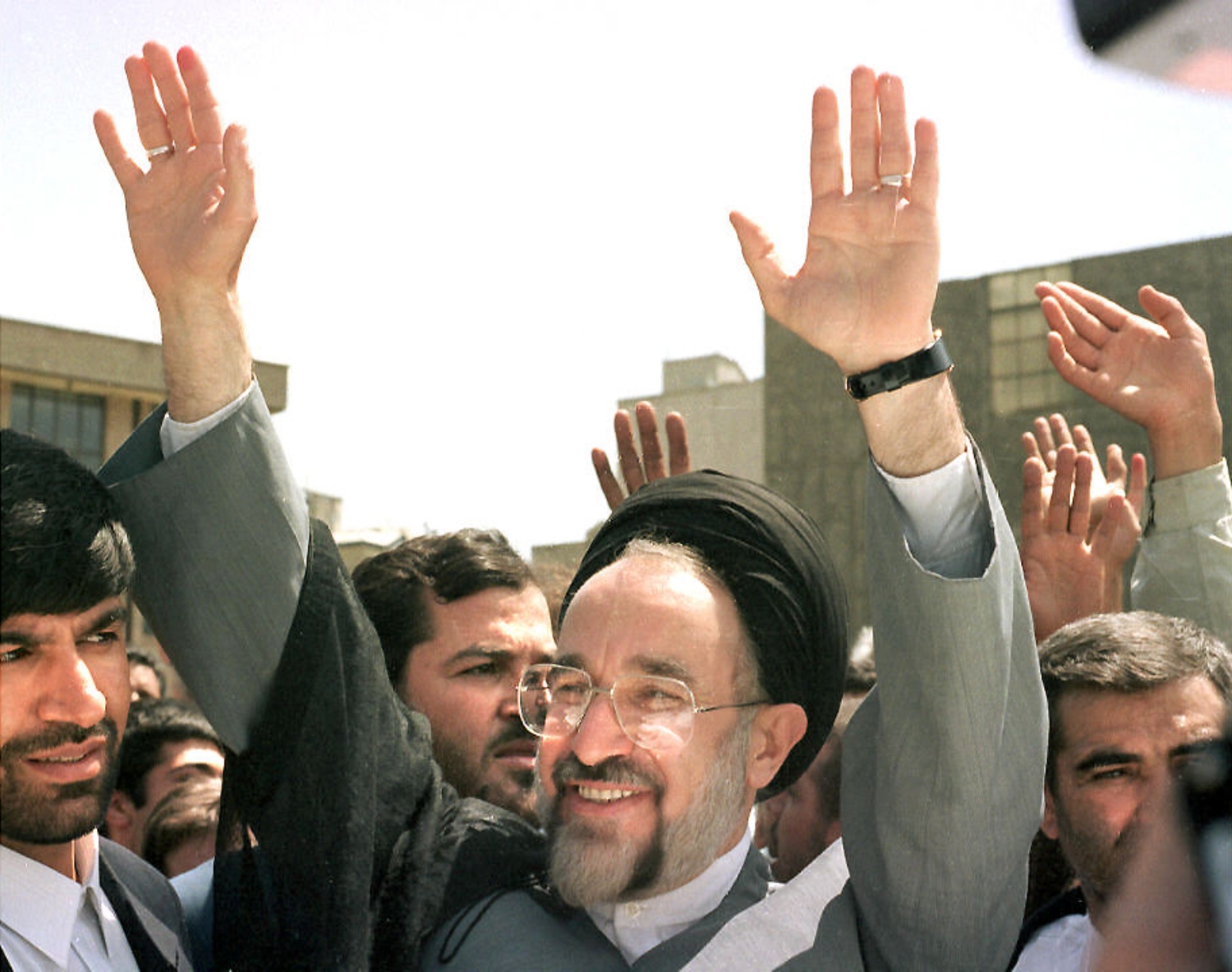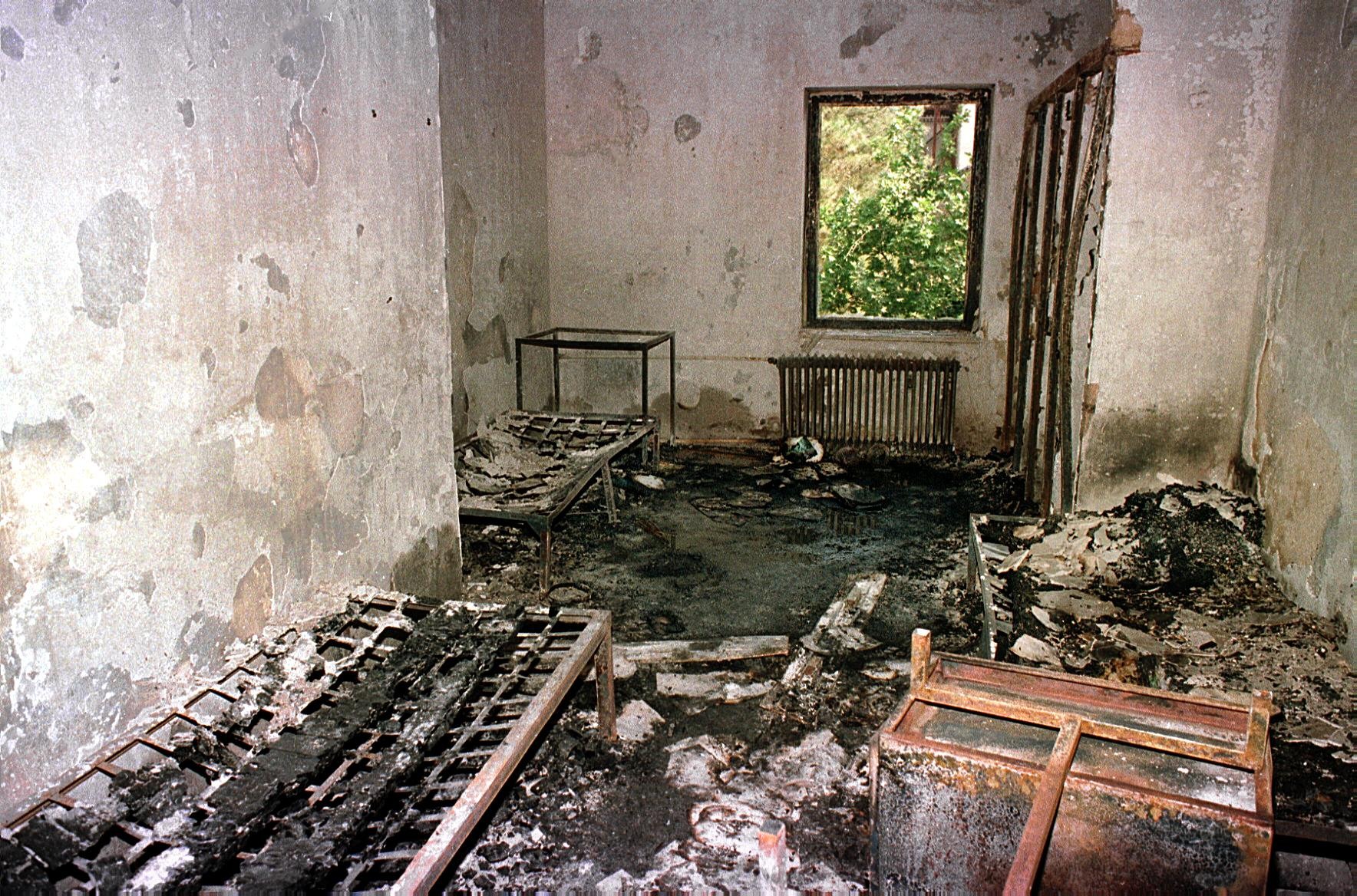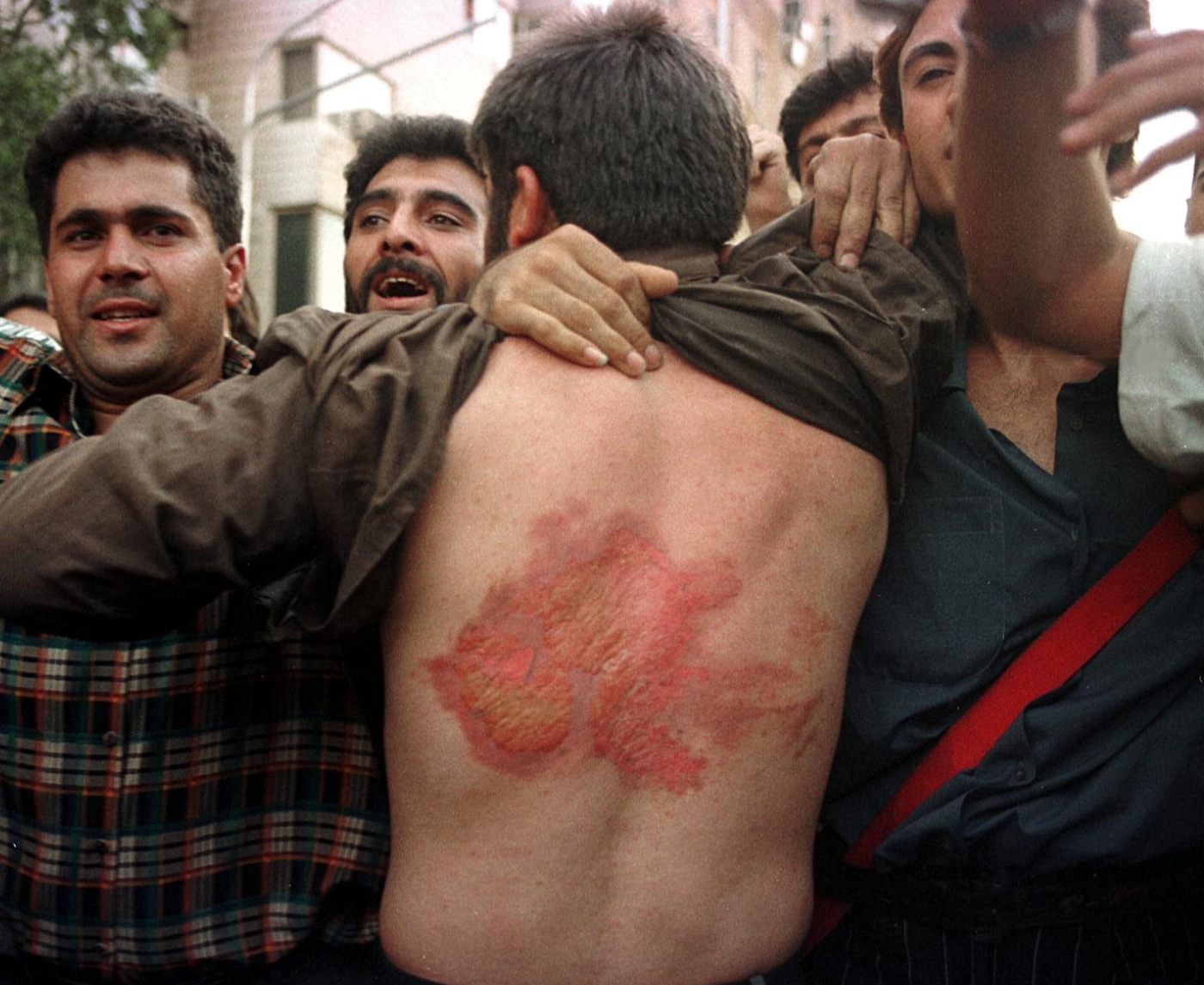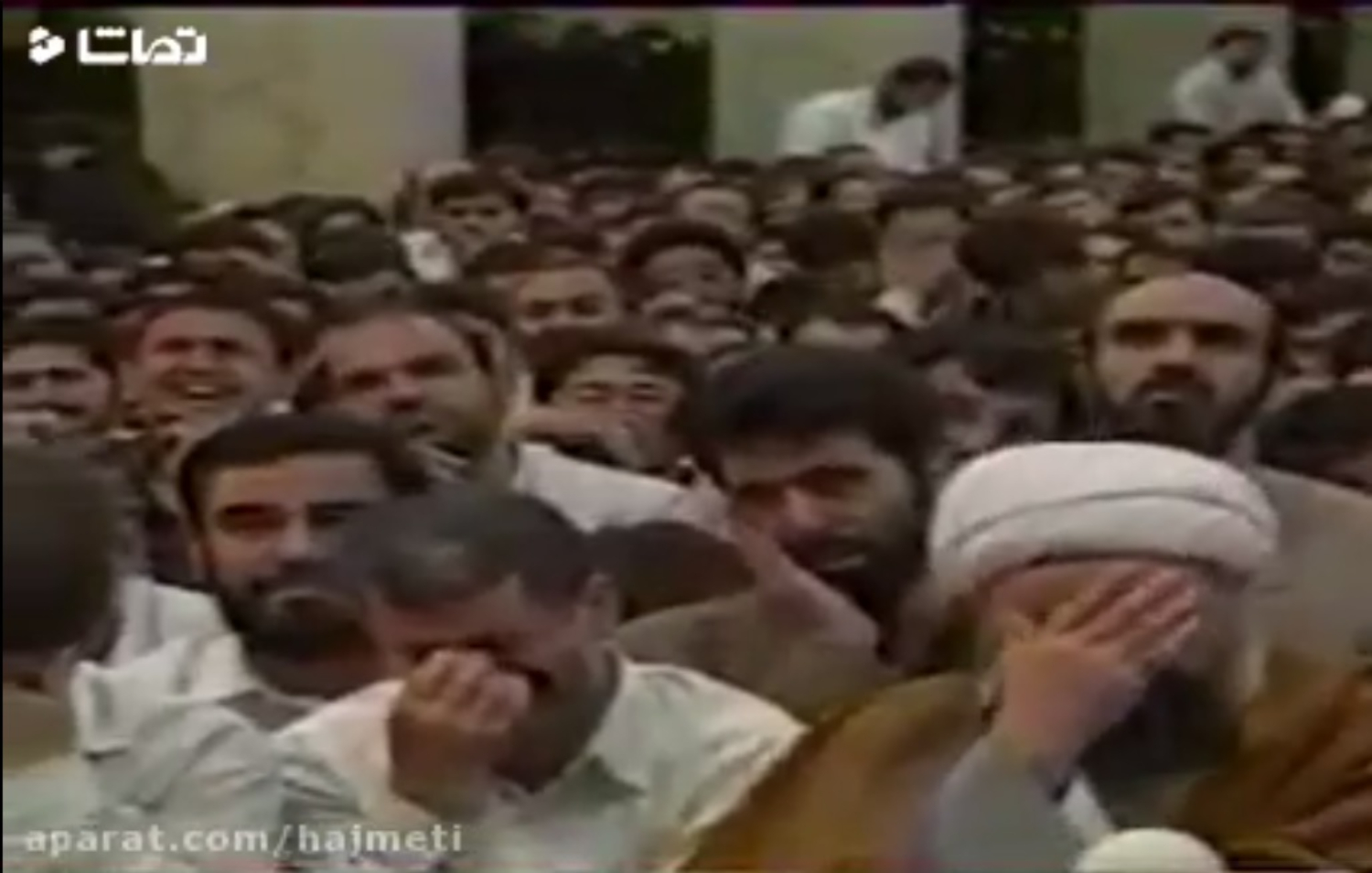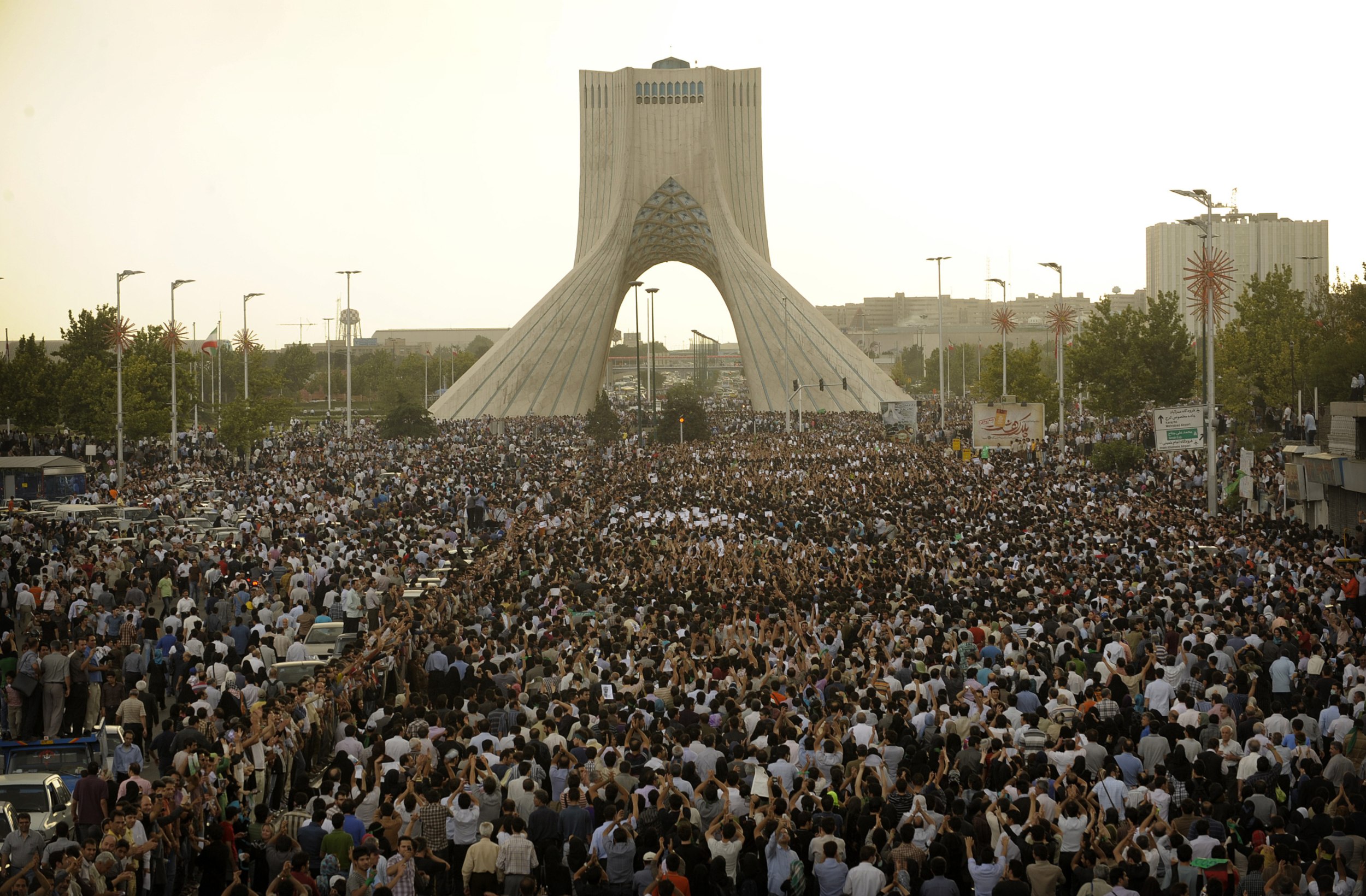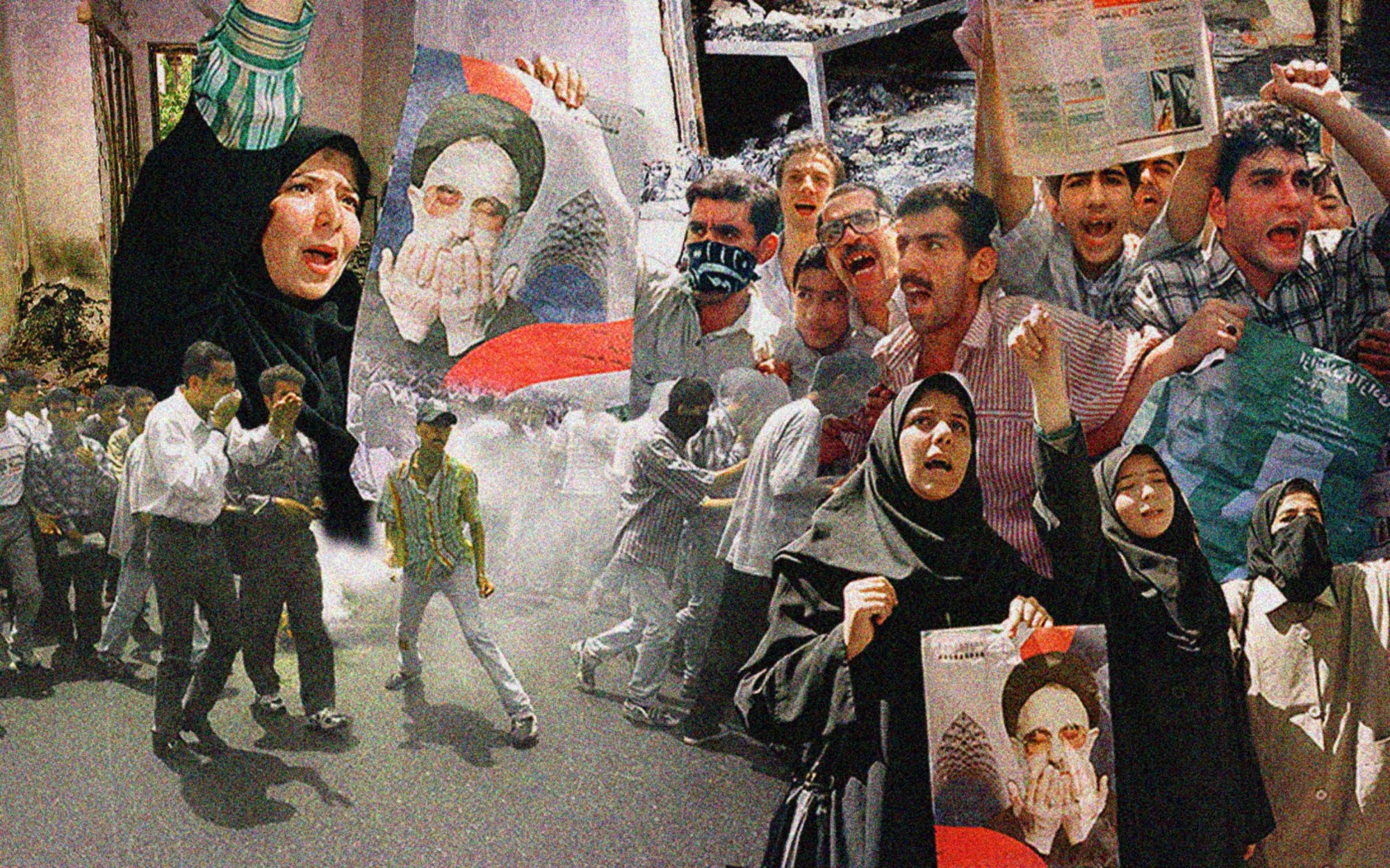
Iran’s 1999 student protests: The hot summer that shook Tehran
The acrid smell of tear gas and smoke lingered in the air as my parents drove me to the dormitories on the University of Tehran campus on the evening of 12 July 1999.
We passed a long caravan of anti-riot vehicles and armed plainclothes members of the Islamic Revolutionary Guard Corps (IRGC) riding on their heavy motorbikes in the same direction as us.
Earlier that day, after nights of sleeping on the grass of the university campus or in one of the prayer halls in the university’s dormitory complex, I had called my parents from a phone booth to let them know I was neither dead nor detained.
As a 20-year-old student in my first year at university, I was among thousands of young Iranians who, during the summer of 1999, rose up in protest against the conservative leadership of the country and its repression of freedom of speech.
My father wanted to talk to me about the situation because he believed that we would be attacked again by undercover forces or the IRGC-linked Basij militia on that night. However, he did not want to discuss this sensitive issue on the phone - no one in Iran has ever trusted a phone line.
Stay informed with MEE's newsletters
Sign up to get the latest alerts, insights and analysis, starting with Turkey Unpacked
The last thing my father told me was: 'Don’t get yourself killed for nothing'
All the streets and alleys leading to the main dormitory complex of the University of Tehran were blocked by riot police and armed militias. As I got out of my parents’ car to continue my path on foot and sneak into the complex, the last thing my father told me was: “Don’t get yourself killed for nothing.”
In 1999, in the absence of proper opposition parties, students and pro-reformist media had become the frontline troops in a struggle for freedom. The conservatives - led by Iran’s Supreme Leader Ayatollah Ali Khamenei - had for two years tolerated small student protests and newspapers’ criticisms, since the election of reformist President Mohammad Khatami.
But between 8 and 13 July 1999, the hardliners decided to crack down on student unrest - and remind reformists of who had the final say in the country.
Iranians remember those five days - known as Fajeh Kuye Daneshgah or “tragedy of the university dormitory” - as the country’s own Tiananmen Square protests.
While this significant chapter of the Iranian student movement is little known globally, what the protesters, myself included, witnessed during those fateful days felt like being in a film.
We witnessed rubbish - and a shoe - being thrown at a representative of the supreme leader. We brought down the enormous gate of the Ministry of Interior. We lost consciousness from tear gas. We felt live bullets whiz past our ears.
Students saw plainclothes officers and paramilitary forces set rooms on fire, throw students off rooftops, shoot plastic bullets directly at students, and leave complete chaos in their wake.
The events of 8 July 1999 and the bloody clashes that ensued left at least four students dead according to official tolls - but the legacy of those few days still resonates 20 years later.
The 1990s political earthquake
On the night my parents came to see me part-way through the protest movement, my mother did not say a word. Years after that July night, I asked her if she had been worried.
“No,” she told me. “I believed in the cause. I just didn’t like the idea of losing one more person.”
For her, the situation had been nothing new. Under the rule of Shah Mohammed Reza Pahlavi, she had lost two brothers and many friends in the fight for freedom.
After the 1979 revolution and the establishment of the Islamic Republic, the political opposition in the country found itself at serious odds with the new people in power. The monarchists left first, taking as much wealth as they could with them as many found a safe haven abroad.
For left-wing Iranians, the transition was more brutal. Leftists had a profound ideological disagreement with the new government, a divergence that resulted in the mass killing of thousands of leftist prisoners between 1981 and 1988 as the Islamists established a total grip on power.
Following this violent backlash, however, the Islamist leadership somewhat relaxed its repression of dissent, paving the way for more moderate forms of opposition to emerge.
Misagh Parsa, a professor of sociology at Dartmouth College and the author of Democracy in Iran: Why It Failed and How It Might Succeed, explained this period to Middle East Eye.
“Once fully in control, Ayatollah Hashemi Rafsanjani and Ayatollah Ali Khamenei decided to move the Islamic Republic in a new direction and steer away from the radicalism of the first decade,” Parsa said, referring to the leftist-Islamist movement that would later be known as reformism.
“The ‘radical’ faction reorganised and entered the [1997] presidential elections as the new reformists, who were primarily concerned with democratic rights, civil liberties and the rule of law. Students also pressed for similar issues and demanded fair elections during the 1997 presidential elections.”
The electoral victory of reformist cleric Mohammad Khatami that year came as a surprise to his supporters and a shock to those in power. At a time when the West was promoting Samuel Huntington’s theory of the "clash of civilisations", Khatami spoke about "dialogue among civilisations"; when Khamenei’s backers pushed for more social restrictions in Iran, Khatami became an advocate for civil society values.
“During his first term, Khatami tried to open up the political system, reduce repression, and granted rights to a large number of new publications,” Parsa explained. “Declining political repression led to greater political activities in universities and the rise of a small group of students that favoured democratic changes.”
The spring of the media
The changing fate of the Iranian press was particularly striking under Khatami.
Leftist-Islamists had been pushed out of Iran’s circle of power in the early 1990s. For the reformists, Salam - a newspaper created in 1991 in the aftermath of the death of Iran’s first supreme leader Ayatollah Rohollah Khomeini two years earlier - had been the only outlet that could express the slightest criticism against the conservatives in power.
However, the situation fundamentally changed after Khatami was elected - leading to what Ali Akbar Ghazizadeh, a prominent Iranian journalist and a professor of media and communications, called a “spring of the media” in Iran between 1997 and 2000.
“Out of journalism school, job opportunities were abundant and we were quickly hired by the mushrooming ‘reformist’ media,” one journalist who launched their career in this period told MEE.
“In those vibrant newsrooms, we, the novices, were sometimes called overindulged in freedom by the veteran journalists,” the journalist recalled of their first professional experiences. “What they meant was that we still had to learn the nuances of this period of relative freedom.
“We had to walk the line, but the lines were blurred and we were over-excited to push them further,” they added.
“In the beginning [of this era], we were so joyful. [...] As journalists, we weren’t even subtle about our involvement in politics, and even now I still don't know if we would do anything differently.”
The reformist press played a vital role in educating Iranians about notions such as civil society, freedom of speech, democratic struggles for change and peaceful reform. It also became a reliable source of news for students when their movement reached its climax in 1999.
But this burst of press freedom was short-lived. While Khatami may have been president, ultimately he answered to Khamenei, who as supreme leader continues to hold ultimate political and religious authority as the Islamic Republic’s head of state.
“Conservatives in the polity opposed much of Khatami’s reformist policies and attempted to derail these changes, resulting in [the] closure of a number of publications,” Parsa said.
It was the closure of Salam, the newspaper that had been such a mainstay of the reformist movement, that ultimately sparked the protests of July 1999 - providing the conservatives, Parsa said, with an “opportunity to carry out their repressive measures”.
A protest like any other
Thursday 8 July 1999 was supposed to be a peaceful demonstration organised by university students condemning the shutdown of Salam - one like hundreds of other protests that had taken place almost weekly in Tehran since Khatami was elected.
That evening, a small crowd of students - no more than 300, by most accounts - convened outside of the dormitory complex, chanting slogans against the conservatives while plainclothes forces stood by.
At the time, we students were taking full advantage of a 46-year-old regulation that forbade armed forces from setting foot on the university campus. Since 1953, police and military forces had been banned from entering university campuses or dormitories after the Shah’s army shot and killed three students and injured 30 more inside the University of Tehran’s faculty of engineering building that year.
However, the ban did not include paramilitary forces or militias. And those were the ones deployed to attack the dormitory complex of the University of Tehran after midnight on 9 July.
Undercover members of the IRGC and Basij paramilitary group had long been deployed to carry out arbitrary arrests, kill political activists and intellectuals and intervene whenever the official armed forces did not want to be seen committing questionable acts.
At around 1 am, as most students who had demonstrated earlier that evening were sound asleep, members of Basij infiltrated the building while uniformed forces stood guard outside.
The attack, swift and ruthless, felt like a blitzkrieg. Rooms were scorched and several students were grievously wounded after being thrown from the rooftop. One student was killed that night.
A day later, the front pages of reformist newspapers were all covered with images of students with open wounds, broken doors of students’ rooms, and bloodstained staircases.
“It was towards the end of my second year in college,” recalled Shervin Amini, a US-based university lecturer whose name has been changed for safety reasons.
“Right after taking my social psychology exam, I heard that the [Basij] militia had attacked the student dorm and that law enforcement had backed them up. Without telling anybody, I grabbed my backpack and headed to the University of Tehran.”
Like him, thousands of students from universities all over the capital rushed to the University of Tehran on 10 July, as if drawn by a magnet following the shocking images and detailed coverage of the events.
As the demonstrations gained critical mass that day, a sit-in in front of the main entrance of the University of Tehran completely shut down the city centre.
Solidarity protests also emerged in cities like Tabriz in northwestern Iran - although students there too would be subjected to violent repression.
'We knew it was the militia, and nobody could cast doubt on the fact that they had nothing to do with foreigners'
“There was some commotion but nothing violent yet,” Amini said of that day.
“Rage and anger kicked in when a representative of the supreme leader, after having just soothed the students, held a megaphone to announce that this is all done by foreign agents and their paid mercenaries.”
Students booed the representative and threw rubbish at him. His claims were too much for these young Iranians, who had been under attack by militias and plainclothes forces at almost every demonstration or protest that had taken place since the 1997 elections.
“We knew it was the militia, and nobody could cast doubt on the fact that they had nothing to do with foreigners,” Amini told MEE. “They are the sworn pawns of the supreme leader and guardians of the Islamic component of political and social life in Iran.
“That statement was uttered, a shoe was thrown at the speaker. This is when the violence started.”
That same night, Amini said the students held a candlelight vigil. He did not remember when exactly he fell asleep on the asphalt, still holding a candle in his hand, but the awakening was brutal.
“I was woken up by a kick in the face. A stream of blood was running down my face, my glasses were broken. The militia had attacked,” he said.
“We ran inside the dorm's gate, broke chairs, benches and tables to defend ourselves with in case they came in. They did not.”
The pressure cooker explodes
During five days and nights of unrest, we were the kings of the campus. We ruled and guarded the University of Tehran’s dorms and buildings, as riot police, Basij forces and plainclothes officers surrounded the complex. We started fires to obscure their view and threw stones at the militia. Several times, clashes erupted in which students and Basij members exchanged blows.
Central Tehran was in complete chaos. The indignation of a generation had burst forth - that of young Iranians known by the political establishment as the “children of the revolution”, born after 1979 and who had only ever known life under the Islamic Republic. It was no longer just about the fate of a newspaper. Our rage could no longer be held back.
While reformist media’s extensive coverage of the events certainly stoked students’ anger, and student organisations called for extensive mobilisation, one could hardly claim the movement was planned or controlled as the crowd grew in size.
That week, a police car was set on fire on Valiasr Square, on Tehran’s main thoroughfare. Students broke into the Ministry of Interior, chanting: “We will kill, we will kill those who killed our brothers,” even as fellow youth, fearing bloodshed, tried to prevent the crowd from storming the building.
Footage of the march on the Ministry of Interior.
Mohammad Esfandiary, now a university lecturer in the UK whose name has also been changed for safety reasons, was a witness to the student uprising. Speaking to MEE, he brought up one incident that for him epitomised how helpless students were in controlling their anger.
On 11 July, reformist parliament member Faezeh Hashemi was one of many political figures who went to the University of Tehran dorms to show her support to the students.
But Faezeh was the daughter of one of the founders of the Islamic Republic, Hashemi Rafsanjani, and she was not welcome there.
“A dozen students encircled Faezeh and her bodyguards. They were enraged, shouting insults to her face, as someone who was regarded as 'establishment' despite being someone who, as a matter of fact, had nothing to do with the attack,” Esfandiary said. “She was an 'untouchable'; well, until that moment.
“The following day came the chants of ‘Death to Khamenei’. Something had changed.”
Flowers and prison breaks
While the battle raged on between Iran’s youth and paramilitary groups, hundreds of thousands of apolitical Iranians showed support for the students - an unprecedented reaction to an anti-government movement.
July 1999 was the first time since 1981 - when the Islamist revolutionaries threw liberals, nationalists and leftists in prison or in front of death squads - that ordinary people backed an uprising. The recent relaxation of press restrictions undoubtedly played a role in this new attitude.
Even if they did not join the protests, residents of the Amirabad neighbourhood of Tehran, where the university dormitory complex was located, would throw flowers from the windows of their apartments in a show of solidarity, the petals gently falling down on us.
'The following day came the chants of ‘Death to Khamenei’. Something had changed'
One night, as I stood with fellow students guarding the entrance of the dormitory complex, we were given a big pot filled with boiled eggs, potatoes and fresh tomatoes.
Some neighbours would take bigger risks, letting the students hide in their homes during the clashes.
Meanwhile, some young Iranians doing their compulsory military service with the IRGC also acted in solidarity with the student movement. One such soldier was Reza Shahabi, not his real name, who also spoke to MEE on condition that his name was not used for safety reasons.
“When the clashes erupted, the headquarters deployed us to the streets but not where the main battles were going on,” Shahabi told MEE.
Shahabi was doing his military service at the time, and recalled how the cadres did not trust soldiers like him because they “were forced to do military service”. He and most soldiers of his rank did not like being used as a means of governmental suppression, he said.
“Very clearly, we sided with the students,” he said. “Most of my friends were university students, and I had close friends who were in the dorms organising the movement.”
When the demonstration spread across central Tehran, Shahabi was deployed to a temporary detention centre very close to the University of Tehran.
“Sometimes the militia and cadres were so busy bringing in new captives that they couldn’t keep a record of them,” he said. “That was when we let some of the students escape when the cadres and militia were not around.”
A movement thwarted
After three days of widespread unrest in Tehran, Khamenei gave a rare speech on 12 July in front of a crowd of supporters. He condemned the attacks on students and called on his supporters to treat students well - even if they tore posters of his image. Nonetheless, the supreme leader said, the protests should end.
Students listened to the speech live on the University of Tehran campus loudspeakers, and they could hear how loudly Khamenei’s supporters cried when he spoke about his photograph being torn. The students burst into laughter at the sound of their sobs.
Meanwhile, Khatami’s meek support of the protest movement was a disappointment for the students. While he condemned the attack on the dorm and several of his ministers and high-ranking advisors paid visits to the University of Tehran during the events, the president’s absence on the scene damaged his reputation among the youth.
On 13 July, authorities organised a massive rally of conservative supporters outside the university. That day, IRGC commanders gave Khatami an ultimatum: either the student movement was to end at the president’s request, or armed forces would take full control of the capital’s security, no matter the cost.
By the evening of 12 July, we knew that the final scene of a five-day cry for freedom was playing out before our eyes. Five days of aspirations, tear gas, indignation, bullets, death, rebellion, temporary triumph, repression and agony were gone. We knew that we had lost the fight.
This was the saddest night of the movement - not because of the militias’ brutality, but because of the furious arguments between students, in which they blamed one another for the uprising’s failure. Had we been too timid? Should our actions have been less confined to the university grounds and its surroundings? Had we been wrong to trust reformist politicians would come to our aid?
In total, pro-protest groups estimated that seven students were killed, 200 wounded, and another 1,400 were detained. Some of those who were arrested faced sentences of up to 10 years, and one person went missing.
The end of an era
Despite official political condemnation of the violence used against the students, in effect the IRGC and state-affiliated militias suffered minimal consequences for their actions. Only one individual was held accountable by the judiciary for his role in the dormitory raid that sparked the crisis - a police officer who was found guilty of stealing trimmers from a room.
Meanwhile, the spring of the media turned into a cold winter.
Mere months after the crackdown on the student movement, pro-reformist news outlets were targeted by the conservatives. By World Press Freedom Day on 3 May 2001, some 20 newspapers, weeklies and monthlies had been banned and several journalists were arrested.
The journalist who had so enthusiastically embraced the newfound openness of the press, was one of hundreds of journalists who left Iran when Mahmoud Ahmadinejad came into power in 2005, as a new era of media crackdown began.
'We were in a different era, I realised. Yet another moment of freedom of the press in our history had passed'
“I was a reporter for [reformist newspaper] Shargh then, and every instruction we received through the fax machine from the judiciary to leave a specific topic out of our coverage made me - one of the ‘overindulged’ in freedom - more aware of reality,” she said.
“We were in a different era, I realised. Yet another moment of freedom of the press in our history had passed.”
On the very day the student uprising was quelled, Amini - who had been one of those crying out for change - also chose exile.
“It was in that moment, two days after my vision got blurred by tear gas and my glasses were broken, that I decided to leave the country,” he said.
“It was not so much out of fragility. It was the feeling of solitude of a population that had a revolution succumb to a new authoritarian regime,” he stressed. “It was not weakness, but an awakening. This was the enlightenment that came out of those dark days; that we are pawns of power as much as the militias. So I left.”
For those who remained in Iran, the 1999 student movement caused cracks in Iran’s political spectrum and struck out the idea of reform.
Khatami was re-elected for a second term in 2001, but the 2005 presidential elections were won by Ahmadinejad - a conservative who had the support of Khamenei.
The governmental crackdown in the wake of the 1999 events widened the gap between the political establishment and swathes of Iranian society - particularly many middle-class religious Tehranis whose children bore the brunt of the repression.
Twenty years after the student uprising, no official memorials have ever been held to commemorate those momentous few days.
In spite of the dejection that prevailed after July 1999, some believe the hope borne during those few summer days planted seeds for the future.
Esfandiary, the UK-based lecturer, believes that the impact the 1999 student movement had on Iranian society became visible a decade later, during the 2009 Green Movement.
That year, as hundreds of thousands of Iranians took to the streets to denounce Ahmadinejad’s re-election, protesters braved clashes with riot police and marched to the University of Tehran dorms to mark the ten-year anniversary of the student uprising.
“The 1999 movement helped shape the citizenry that in 2009 cried for its rights - what it believed, it knew, were its rights,” he said. “Not many took part [in the 1999 demonstrations]. But many took note: so you could express your discontent after all; you could hit back, even if it meant getting hit back even harder.
“It was 1999 that put them on the course - on the collective, intellectual journey - that made the Million March (of 15 June 2009) possible,” he added.
“This fundamental shift in attitude was a prerequisite to 2009 - just as the 2009 will be for the next one to come.”
Middle East Eye delivers independent and unrivalled coverage and analysis of the Middle East, North Africa and beyond. To learn more about republishing this content and the associated fees, please fill out this form. More about MEE can be found here.


